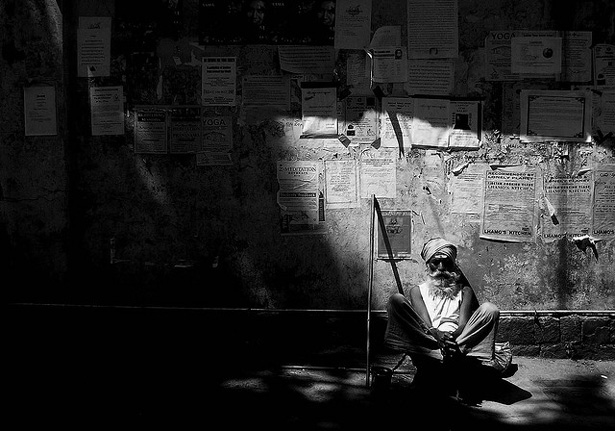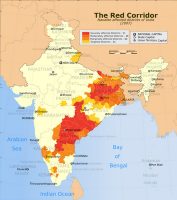-
India’s Maoists: South Asia’s “Other” Insurgency
July 7, 2010 By Schuyler Null
The Indian government’s battle with Maoist and tribal rebels – which affects 22 of India’s 35 states and territories, according to Foreign Policy and in 2009 killed more people than any year since 1971 – has been largely ignored in the West. That should change, as South Asia’s “other” insurgency, fomenting in the world’s largest democracy and a key U.S. partner, offers valuable lessons about the role of resource management and stable development in preventing conflict.
The nation’s “single biggest internal security challenge”The Indian Maoist movement (sometimes called Naxalism) can be traced back to a 1967 communist rebellion in the West Bengal town of Naxal. The latest incarnation of the movement (which the Prime Minister has called the nation’s “single biggest internal security challenge”) is aided by an aligning of interests between Maoists insurgents and Adivasi tribals – native Indians who live a predominately traditional lifestyle – in the central and eastern corridor of the country.
For the Greater Good
Although the Maoists are largely politically motivated (see similar movements in Nepal and the Philippines), the tribals are driven by grievances with the Indian government over decades-long resource mismanagement and systematic marginalization beginning with a series of development projects in the 1980s that removed tribals from their lands in the name of the public good.
First, to address widespread power and infrastructure shortages, the government began acquiring land and establishing large-scale mining operations in the country’s mineral-rich but underdeveloped eastern provinces. However, much of the land designated was inhabited by tribals. As a result, millions of Adivasis were resettled and rehabilitated by government mandate.Second, the government enacted the Forest Protection Act of 1980. Although the legislation was an attempt to protect the country’s natural resources from exploitation, by assigning forest officials extraordinary powers to regulate development and even habitation rights, the law essentially outlawed the existence of many tribal villages that had been in place for centuries. According to an Institute of South Asian Studies report:
As areas were delineated as reserve forests, traditional occupations of even gathering twigs (‘lops and tops’ in the forester’s language) was forbidden. People who earned their livelihood through access to forest resources in a sustainable manner suddenly found themselves outside the law. Further, this Act did not distinguish between habitations that existed within the forests for generations; the habitants suddenly found themselves to be encroachers on their own traditional land.
Maoists and Insurgency
Even though 2008 legislation gave tribals the right to live in protected areas, animosity towards the government has grown substantially, exacerbated by the lack of basic development support to tribal villages. According to the UN State of the World’s Indigenous Peoples report, poverty levels among tribals have persisted over the last decade, where other sectors have improved. In fact, tribal poverty today is worse than that of the Scheduled Castes and on par with those of sub-Saharan African countries.
As a result, the Maoists, whose ultimate aim is to overthrow the Indian government, have found fertile ground in tribal areas for their recruiting activities, as Foreign Policy reports:
Naxalism has taken root in villages that have been completely ignored by the government. In the rebel-controlled villages, as in most tribal Indian villages, life hasn’t changed for decades. There is no electricity, schools, or hospitals. People die of snake bites and treatable diseases like malaria and tetanus. Villages are full of naked, chronically malnourished children with distended bellies. Gaunt men clad in dirty loincloths toil in scorched farms, while women in frayed saris look after the goat and cow barns outside mud-and-clay huts, worried about the next meal. Many tribals survive on leaves and berries.
Meanwhile, government and private mining efforts, which The Guardian reports have been criticized by NGOs for human rights and environmental violations, continue to expand into tribal areas, inciting violence between security forces and rebels and further aligning Naxal-Adivasi interests. Today, according to the Asia Times, 40 percent of India’s top 50 mineral-rich districts are affected by insurgent violence, and a CSIS brief reports that the affected states include 85 percent of India’s coal reserves.
Government resettlement programs in these areas are clearly partly at fault for the recent uptick in violence. In 2007, the U.S. State Department reported that according to India’s latest census, about 55 percent of people displaced by development projects were tribals, even though they account for only 8 percent of the total population.Paying the Price
As long as Maoists continue to appear better equipped to provide basic governance and support to the tribals, Adivasi support for the insurgency seems unlikely to end, and the duality of the challenge – development grievances for the tribals and political grievances for the Maoists – as well as its size and scope, make it unlikely the state can end the insurgency through brute force alone (a la Sri Lanka’s recent campaign against the Tamil Tigers).
India seeks a place on the world stage and its rapidly expanding economy and growing population demand access to natural resources, but the government cannot continue to ignore the rights and needs of its most marginalized citizens. Funds have been pledged for some tribal development projects in the northeast but more is needed in the “Red Corridor” area of the country to prevent the “greatest threat to internal security” from finding new recruits even easier to come by in the coming years.Sources: Asia Times, Asian Tribune, Atlantic Council, CSIS, Christian Science Monitor, Foreign Policy, Guardian, Hindustan Times, Institute of South Asian Studies, Prime Minister’s Office of India, South Asian Intelligence Review, UN, U.S. State Department.
Photo Credits: “Wandering Aesthetic” courtesy of flickr user Wen-Yan King, “India Mineral Map” courtesy of blogspot user madhukar, and “India Red Corridor Map” courtesy of Wikimedia commons.
 A Publication of the Stimson Center.
A Publication of the Stimson Center.





